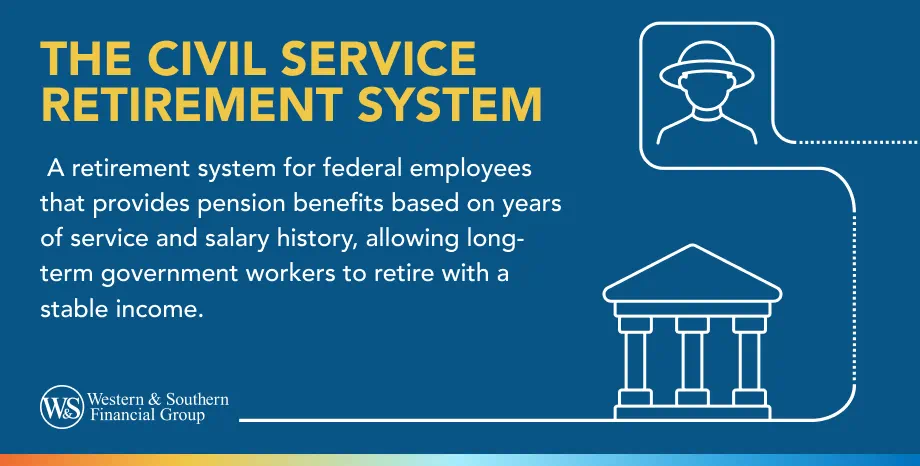Table of Contents
Table of Contents


Key Takeaways
- Employees hired before 1987 contribute 7%-8% of pay to CSRS for retirement benefits.
- CSRS benefits can be increased through a VCA or TSP, though TSP has no employer match.
- Monthly benefits are based on years of service and your highest three consecutive salary years.
- At least five years of service is needed to qualify for CSRS annuity benefits, with higher percentages for longer service.
- CSRS benefits are available through immediate, deferred, early, or disability retirement, but don't include Social Security.
The Civil Service Retirement System (CSRS) is a defined benefit and contributory retirement program. Federal employees share in the expense of the annuities on which the system is based. Upon retirement, federal employees receive monthly benefits from those annuities.
The CSRS was replaced by the Federal Employees Retirement System (FERS) for government employees who entered covered service as of January 1, 1987. However, the CSRS still affects many current employees. Since federal employee retirement is different from Social Security and other retirement plans, it can be helpful to understand how the CSRS works. Here's some information to keep in mind.
Options for Paying Into the CSRS
Federal employees who began their service prior to January 1, 1987 are eligible for CSRS retirement benefits.
- Covered employees contribute between 7%-8% of their pay to the CSRS, and they generally are exempt from paying Social Security taxes, although they are required to pay Medicare tax, according to the U.S. Office of Personnel Management (OPM).1 The agency employing workers who are covered by the CSRS then matches the employee's contributions.
In addition to the standard match of 7%-8% of employee contributions, you can increase your annuity benefit in retirement in two other ways.
- Make a contribution of up to 10% of your basic pay to a voluntary contribution account (VCA). Your VCA contributions are made after taxes, and total contributions may not exceed 10% of the total basic pay you received during all of your CSRS-covered employment. You can make this contribution through a payroll deduction of 10% per paycheck, through several deposits over time or even as a single large check as you approach retirement.
- Contribute a portion of your pay to a Thrift Savings Plan (TSP). This tax-advantaged retirement savings plan allows you to set aside pretax income in a retirement account. However, you are not eligible for an employer match of your contributions to your TSP.
Select from contribution options to help grow your federal retirement fund. Start Your Free Plan
How the CSRS Benefits Are Calculated
The amount of your monthly benefit is calculated based on two factors:
- Your length of service
- Average salaries of your three highest paid consecutive years (known as your "high-3"), according to the OPM (any bonuses or overtime you receive are not included in your high-3 calculation)2
Since you generally earn more money the longer you stay in service, you may see your high-3 (and therefore your annuity benefit) go up over the course of your career. You also need at least five years of service to receive CSRS annuity benefits after retirement, and your benefit will likely go up the longer you have served.
- Five years of service - receive 1.5% of their high-3 salary annually
- 5-10 years of service - receive the 1.5% of their high-3 for their first five years of service, plus 1.75% for the next five
- 10+ years of service - receive the 1.5%, plus the 1.75%, plus 2% of their high-3 for each year served after year 10
Finally, if you retire prior to age 55, your benefit will be reduced by one-sixth of a percent for each month that you are shy of your 55th birthday.
Receiving Your CSRS Benefits
If you retire from your CSRS-covered employment after age 62, you are eligible to receive your annuity benefits within 30 days of your retirement.
However, there are other ways to receive your CSRS benefits:
- Deferred retirement: If you leave your CSRS-covered employment before reaching the age and service requirements for an immediate retirement benefit, you may be eligible for a deferred retirement. This is available for covered employees who have at least five years of creditable service and who have reached age 62, although the age requirement is lower if you have more years of creditable service, according to the OPM.3
- Involuntary separation: If you are forced to retire because of a reorganization or reduction in force, and you meet several requirements, you can take your retirement benefits as early as age 50. However, your benefit will be reduced if you are under the age of 55.
- Disability: If you are forced to retire because of a disability and have served at least five years, you may be eligible for CSRS benefits.
Since employees who are covered by the Civil Service Retirement System are generally not eligible for Social Security, it's important to know exactly what to expect from your CSRS benefits. Understanding how to calculate your benefit, and the effect of a VCA and TSP, can help you start planning.
Maximize retirement income by contributing to both voluntary accounts and savings plans. Start Your Free Plan
Sources
- CSRS Information. https://www.opm.gov/retirement-center/csrs-information/.
- Computation. https://www.opm.gov/retirement-center/csrs-information/computation/.
- Eligibility. https://www.opm.gov/retirement-center/csrs-information/eligibility/.




























